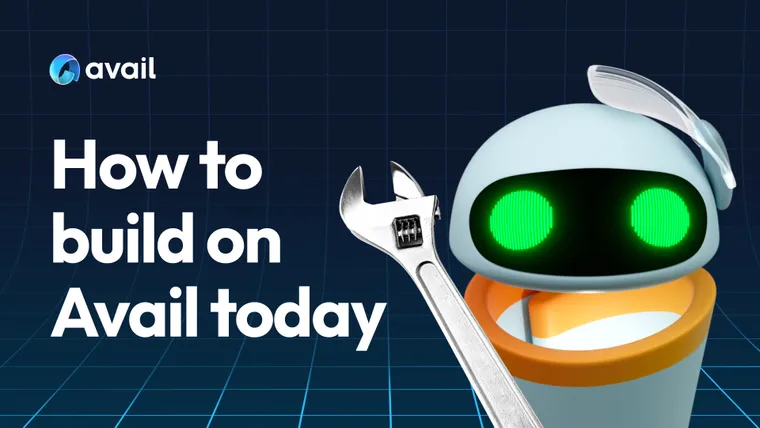Avail makes it easy to build with secure, scalable and interoperable blockchains. Regardless of how much development experience you have with blockchains or smart-contracts, we’ll help you select the right development pathway and get you building on Avail in on time!
Topics we’ll cover below:
- Ways to build on Avail
- Useful mental models
- Development pathway 1 - Build and deploy in Production
- Development Pathway 2: Tooling & Infrastructure
- What to build?
- Join the developer community
- Helpful Resources
We’re assuming that you’re already familiar with key concepts mentioned in this post, but if you need a quick refresher, here are some resources that you may find helpful:
- What is Avail?
- What is Data availability?
- Modular vs Monolithic blockchains
- Avail’s core features explained
- A guide to selecting the right DA layer
- Awesome Avail Github Repo
There are more links to resources and project ideas throughout this post, so let’s get started.
Ways to build on Avail
There’s two key development pathways when building on the Avail Network. You can build and deploy your own blockchain, or you can build tooling and infrastructure that improves the Avail ecosystem.
Soon, developers will also be able to leverage the Avail network for cross-chain interoperability.
Useful Mental Models
If you’re already familiar with how Avail fits into the wider blockchain landscape, feel free to skip over this section and find a development pathway below.
Here are some useful mental models to show how you can build highly performant rollups with Avail. This is just a short list, for more details check out the Avail docs.
Avail DA is effortless
With Avail DA, you don’t need to worry about setting up and managing a data availability committee (DAC) or paying expensive fees to use data availability on Ethereum. Instead, Avail DA provides a decentralized, efficient, and cryptographically secure data availability network for rollups out of the box.
Avail DA is well suited for high volume blockchain use cases
Avail DA is live on mainnet. It’s built from the ground up to provide data availability capacity for other blockchains. It’s optimized to provide fast, efficient and affordable data availability guarantees which are cryptographically secured by validity proofs and independently verifiable by light clients. This makes Avail DA well suited for high volume use cases like social media, DeFi and web3 gaming.
Avail is Decentralized
Avail utilizes Nominated Proof-of-Stake (NPoS), the most decentralized PoS based blockchain design available. NPoS avoids validator centralization risks that are common amongst Delegated Proof-of-Stake (DPoS) based blockchains.
Anyone can verify Avail’s DA guarantees by independently running the Avail light client, which can run on a user’s phone, laptop or smart watch.
Avail DA is optimized for ZK based chains
Avail DA is the most optimal choice for ZK based rollups as it is built using KZG commitments and validity proofs. Any team looking to implement ZK based execution in their modular tech stack can benefit a lot by integrating with Avail DA. This is because ZK based execution environments and Avail DA provide proofs that can be verified quickly without waiting for a challenge period.
While there’s a lot to gain from a ZK based rollup on Avail DA, it’s worth pointing out that Avail DA is designed to work just fine with optimistic based designs too.
Avail is built for Interoperability
Those familiar with the concept of chain abstraction can utilize Avail Nexus, a hub which facilitates cross-chain transactions with ease across any ecosystem. It’s a ZK verification rollup utilizing proof aggregation, built on top of Avail DA and is currently under active development.
Modular Blockchains: Avail DA + Any Execution + Any Settlement
Modular blockchains give you plenty of flexibility to combine different components for your ideal blockchain. To build a modular blockchain with Avail you just need to pair Avail DA with an execution environment of your choice.
Avail is integrated with the 5 most popular Ethereum rollup stacks, as well as other non-EVM based execution environments. Avail DA can be implemented using Rollup-as-a-Service providers and SDKs that make it simple to deploy various modular blockchain constructs in just a few clicks. Transactions can be settled on Ethereum. A data root from finalized Avail blocks gets relayed to a smart contract on Ethereum for transaction finalization (more on this in the diagram below).
Development Pathway 1: Build and Deploy in Production
This pathway is for developers working towards deploying a blockchain in production using Avail DA. We’ve broken this development pathway into three phases that help you progress from deploying a smart contract on an Avail powered rollup, to setting up and deploying your own custom blockchain on Avail DA.
The Tinkerer: Deploy a Smart Contract on an Avail Powered Rollup
This option is great for smart contract developers who want to get a feel for Avail DA, without needing to learn too many new concepts. If you’ve deployed a smart contract on an EVM chain before, then you’re already well on your way.
By following this exercise you can begin to experiment with Avail DA and see how it quickly provides verifiable DA guarantees that you can verify from almost any device using an Avail Light Client. You can also enjoy the low fees and flexibility of Avail DA.
You can deploy your smart contract to an Avail powered rollup on one of these chains. Avail DA is working behind the scenes and you can simply deploy your smart contract on the testnet chain. Transaction data from the rollup (including your smart-contract transactions) will be automatically submitted to Avail DA.
This implementation significantly reduces the operating costs for your smart contract and is one of the simplest ways to get a feel for what Avail DA does behind the scenes, especially for smart contract devs.
Here’s a closer look at how you can verify data availability on Ethereum. The data root from Avail is posted to Ethereum through the VectorX bridge. We can verify on Ethereum that the data is posted on Avail using VectorX, by verifying that a blob leaf is included in the data root. We can then fetch the data from Avail using the block reference on Ethereum.
The Explorer: Deploy a Rollup with a RaaS provider
Those who want to build a custom rollup but aren’t quite ready to configure and deploy one alone, can use one of many Rollup-as-a-Service (RaaS) providers integrated with Avail.
Rather than deploy your smart contract on an existing rollup like before, you can now deploy your own rollup using a RaaS provider. Then you can deploy your smart contract on your rollup if you want to. So far we have been using smart contracts on Ethereum as a reference for easier comprehension. It’s worth pointing out the Avail Network provides a general purpose data availability solution, allowing you to use any execution environment in your rollup, including non-EVM ones. RaaS providers make it really simple to get your new rollup into production, handling the provisioning of hardware and getting everything set up for you.
If you’re not yet ready to deploy a rollup into production, you can still deploy a new rollup using a testnet and get a feel for how everything works. When selecting your rollup tech stack, you just need to select Avail DA as your DA layer and the RaaS provider will take care of the rest. Avail DA will be making sure your transaction data is available to all rollup nodes. You inherit all of Avail’s core features like Avail light clients which enable verification from almost any device.
The Adventure Warrior: Configure & Deploy a custom blockchain on Avail DA
While this process is relatively straightforward, it’s the most hands-on of the three development pathways, yet it provides you with the greatest level of flexibility. You can set up things exactly the way you want, ensuring every part of your tech stack is optimized for your ideal use case and performance.
With this development pathway you can build Optimiums, Validiums, Sovereign Rollups and BTC L2s. You can use any execution environment with all of Avail’s infrastructure at your fingertips. To get started you can leverage one of Avail’s many integration partners to configure the ideal tech stack for you. If you’re not sure on the best choice, get in touch and the team will help you find the right tech stack for your needs.
Development Pathway 2: Tooling & Infrastructure
This development pathway is a little different to development pathway one and is great for those looking to help contribute to the Avail Network. With this development pathway, you can enhance the overall Avail experience by building something new or integrate existing web3 tooling and infrastructure with Avail.
The Creator: New Chain Designs & Enhancements
There’s plenty of opportunities to build something new for the Avail ecosystem. This can be through building useful tools for developers and users like explorers, staking and bridging interfaces or liquid staking protocols.
There’s also a lot of exciting opportunities to leverage Avail’s validity proven infrastructure in new and interesting ways. Specifically when it comes to implementing the Avail light client to experiment with new chain designs. The key being that Avail’s light client enables you to verify DA validity proofs locally.
Some may spot an opportunity to help improve the Avail ecosystem, enhancing the way Avail is monitored, integrated or implemented. This could include projects that provide new data visualizations, tooling or ZK implementations. As a permissionless platform you have full flexibility to create something truly unique.
The Avail team is here to help. You may even like to support the explorations team as they build out new, unexplored territories of the Avail ecosystem by contributing towards one of Avail’s uncharted projects.
The Connector: Integrations
The collaborative nature of web3 is even further enhanced by the collaborative ethos of the modular blockchain community. With new projects enhancing modular blockchain development, like RaaS platforms, execution environments, SDKs and more, there are plenty of opportunities to integrate new modular components with Avail. Developers looking to extend their tools and technologies can integrate with Avail and join Avail’s rapidly growing ecosystem.
What to build?
Teams are building app specific chains, BTC L2s, DeFi applications, web3 games and more with Avail.
You can use Avail DA to build custom blockchain applications, or even migrate existing applications to Avail DA for improved efficiency and performance.
Now that the Avail DA mainnet has launched, the next leg of the journey starts.
— Anurag Arjun (@anuragarjun) July 29, 2024
First priority is to onboard as many chains as possible. Those of you who are considering spinning up a new chain, please feel free to contact me or the team. @KyleArojas @chandlerdkk @ri5hitripathi…
If you’re looking for more inspiration, here are some hackathon projects that might help spark some ideas.
- Tok2Tok: Call all best AI services! Pay with tokens! Enjoy the power of AI!
- zkDNS: A privacy preserving multi-chain domain resolver that uses ZkProofs.
- Cats Dogs Memes: Play game with memes! Fun time! Win NFTs! Blockchain magic!
- L3S: L3S offers shared security with liquid staking to protocols.
You can see more project ideas in this hackathon guide.
Join the Developer Community
Join the developer community on Discord and Telegram. Say hi to @robin and @naruto who can help guide you through your development journey and connect you with the rest of the development team.
Helpful Resources
To start your journey with Avail, check out this awesome-avail github repo to find links to everything you will need.


